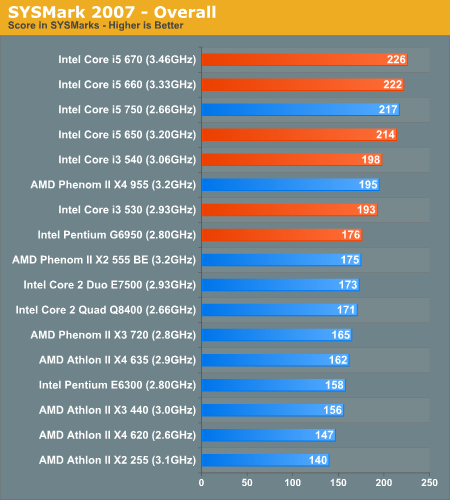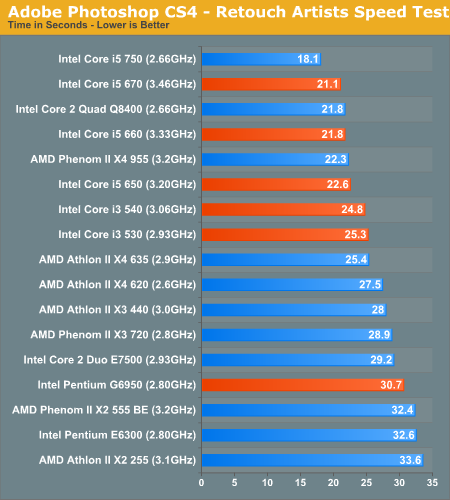The Rest of Clarkdale: Intel's Pentium G6950 & Core i5 650/660/670 Reviewed
by Anand Lal Shimpi on March 24, 2010 4:00 PM EST- Posted in
- CPUs
SYSMark 2007 Performance
Our journey starts with SYSMark 2007, the only all-encompassing performance suite in our review today. The idea here is simple: one benchmark to indicate the overall performance of your machine.

SYSMark ends up being a fairly lightly threaded test, optimized mostly for dual core processors. As such, the Athlon II X3 doesn't really get much benefit from that third core and ends up being more of a Penryn competitor than in the same class as the Core i5/i3 and Pentium G6950.
As a business desktop machine, the Pentium G6950 is a competant option. Clearly slower than the Core i3 530 but not much else. The faster dual core i5s do well here.
Adobe Photoshop CS4 Performance
To measure performance under Photoshop CS4 we turn to the Retouch Artists’ Speed Test. The test does basic photo editing; there are a couple of color space conversions, many layer creations, color curve adjustment, image and canvas size adjustment, unsharp mask, and finally a gaussian blur performed on the entire image.
The whole process is timed and thanks to the use of Intel's X25-M SSD as our test bed hard drive, performance is far more predictable than back when we used to test on mechanical disks.
Time is reported in seconds and the lower numbers mean better performance. The test is multithreaded and can hit all four cores in a quad-core machine.

For a photoshop workstation, Intel's quad-core i5 can't be beat by anything in the i5 lineup - even if you spend more than $200. The Pentium G6950 doesn't do so well here. While it's faster than the Pentium E6300, it's slower than the Core 2 Duo E7500 and AMD's Athlon II X3 440. Photoshop likes to spawn CPU intensive threads and thus Hyper Threading actually matters here. You'll want at least an i5 if you're building a good Photoshop box.










70 Comments
View All Comments
larson0699 - Thursday, March 25, 2010 - link
@GP(iwodo)-- I like the architecture just fine, but (in the case of i3/i5) to hand the memory controller over to the IGP (when, in Nehalem, it was on-die to begin with) is a shot in the foot. What gives? A lot of us use these chips with discrete GPUs, and even the ones who don't aren't seeing the potential of the architecture because of this stupidity in design--simpler or not (than going monolithic out of the gate). It's a step backward, but even so, still marginally superior to Conroe/Penryn in performance alone. Performance per Watt is definitely more of a win here for those like myself who care how productively any given amount of energy was used.@P(kaleun)-- Sandy Bridge doesn't look like much of an upgrade to i7 anyway. The roadmap suggests that the performance CPUs will remain independent of GPUs as they logically should. I don't know anyone (including "power users") who upgrades at every tick and tock. And perhaps it hadn't occurred to you that LGA775 is and will be an upgrade path for those on a budget tighter than LGA1156 can entertain *until* the day it does. We're really scraping the bucket here, but (after just looking) one could put together a quality G41 board, 4 gigs 6400, and an E3300 (with hope to overclock the piss out of it) for $174. Naturally, the next "tick" (Sandy Bridge) will be the final nail in the coffin, but in the meantime, 775's fair game.
kevinqian - Wednesday, March 24, 2010 - link
I think the recommendation for it as HTPC is nullified because bitstreaming is not supported on the Pentium G series! I'm not even sure if it supports 8ch LPCM.larson0699 - Wednesday, March 24, 2010 - link
[quote]The Core i5 660 is just like the 661 we reviewed in January but with a 733MHz GPU clock instead of 900MHz.[/quote]Anand,
I feel it is also worth mentioning here that the 661 lacks VT, as the quoted statement suggests that GPU clock is the only difference.
But great article.
I'm just uncomfortable with the choice of a 3.33GHz dual/HT vs. 2.66 quad at the same price point. I find their clock speed selection a little obvious considering that and HT create such a linear product path:
Quad/HT+Turbo > Quad > (high clock) Dual/HT+Turbo > Dual
Is it possible that the G6950 could outperform an i3 simply because each core handles a single thread? I knew better than to think, for instance, that the 660 is logically four 1.66GHz cores... But I don't know exactly how HT allocates processor time, if it does dynamically (again, not thinking it simply splits the core down the middle, always leaving a core half idle if running 1 thread).. Would a kind soul please link me to reference? (I'm looking too)
yuhong - Thursday, March 25, 2010 - link
The 661 lacks VT*-d*, not VT*-x*, which even the G9650 have.larson0699 - Friday, March 26, 2010 - link
I stand corrected. A difference nonetheless.kaleun - Wednesday, March 24, 2010 - link
considering overall cost of the platform (at minimum board + RAM + CPU) plus maybe case, PSU, HDDs, monitor, graphics, OS etc. I think saving $ 25 to get the Pentium over the i3 530 is silly. Maybe in the future one uses more multi-threaded applications, then HT comes in handy.People always compare CPU prices and are happy to save $ 25 or so. But a CPU alone is worthless. A decent PC costs $ 500 + with quality equipment that is fast and has a long life. (don't come me with those $ 25 case + PSU combos!!!).
After the purchase I have never heard anyone saying: "I wish I had saved $ 25 and would have a slower CPU." the same way no one ever wished to have less memory.
larson0699 - Thursday, March 25, 2010 - link
Agreed. The Pentium would be a hit if it were priced against the i3 for everything it _doesn't_ have, instead of against C2D for all that it _does_. I'm thinking $75 wouldn't have meant a catastrophic loss for Intel, considering most are buying left and right of it anyway.HT, 166MHz of GPU, the meg of L3, and the RAM speed discrepancy just aren't worth saving $25. And since it's the most crippled Pentium ever, it should've been a Celeron.
KaarlisK - Thursday, March 25, 2010 - link
The 25$ does matter when your buying 20PCs - and, in my case, it's not 25$ but 25€. And for those 25€x20 I can buy two-three more PCs, meaning two more teachers with a new computer on their desks.Also, I will regret saving $25 on a motherboard (getting a G41 instead of a H55 means losing AHCI and GMA HD Graphics), I will regret not spending money on an SSD (roaming profiles, so all I need is a boot drive), I will regret not spending money on a quality case (have had far too many PSU/PSU fan failures), and I might regret choosing 2GB instead of 4GB RAM (might impact performance with future OSes/apps).
I don't see how I will regret not buying an i3 530. Nobody will be using Photoshop/x264/Blender/RAR/etc much in the future anyway. So even though there is no reason to choose the G6950 from a price/perf perspective, it's the one saving I can afford to make, so I will.
larson0699 - Friday, March 26, 2010 - link
That is absurd.Assuming your teachers actually need HD decode in hardware, step up to G43/G45, a board with X4500HD, and you still save measurably against H55. You're going to retard the CPU in favor of SSD--seriously?? And who buys "quality" cases (= no PSU, a sure bet) in bulk? Three words: Antec. Coolermaster. Silverstone. Bundle it up, man, you've got way better options before you. My example included 4 gigs, as I wouldn't run any less with Vista/7. Of course, you'll need every byte of it when you let the background processes, Search/Indexing, and Superfetch run rampant on an out-of-box registry--as I'm under the impression you'd also regret the manual overhead of deploying a tailored system through RIS or whatever it is now. And I can guarantee you that a two-thread processor will be at the mercy of the next OS by indication of trends. Forget it. If you don't wind up with a whole new platform by that time (let's see, because you chose the PENTIUM from the get-go) you'll be forfeiting that savings with the purchase of 20+ i3's or better.
In my IT experience with school systems Stateside, NEVER have I walked into a school whose staff decided, "Who needs a preconfigured PC when we can instead BUILD a thousand machines?". And you know why it isn't practical? Education discounts. Volume discounts. Contracts and affiliations. Now show me that those cheap Pentiums are actually cheaper than i3 Lenovos or Dells in bulk, WITH warranty. Busted.
KaarlisK - Thursday, March 25, 2010 - link
Oh, and I'll overclock the GPU to 733/900MHz anyway ;)